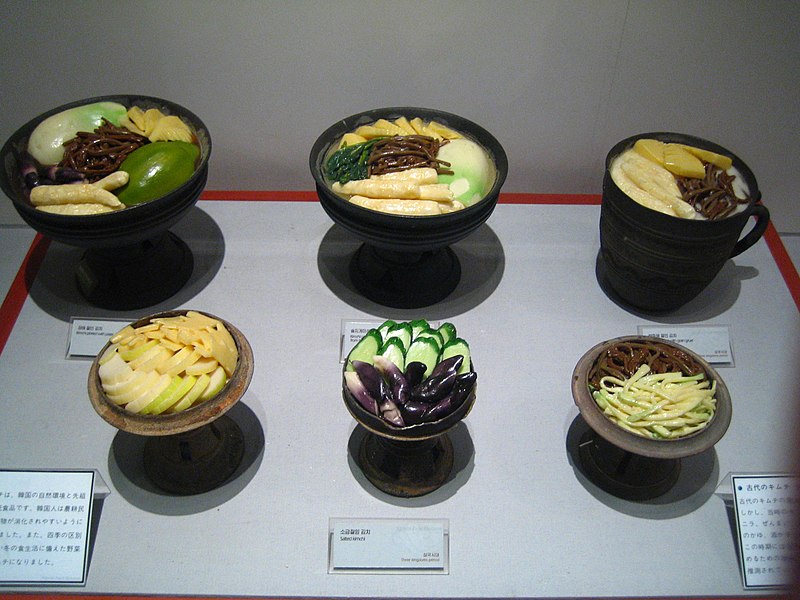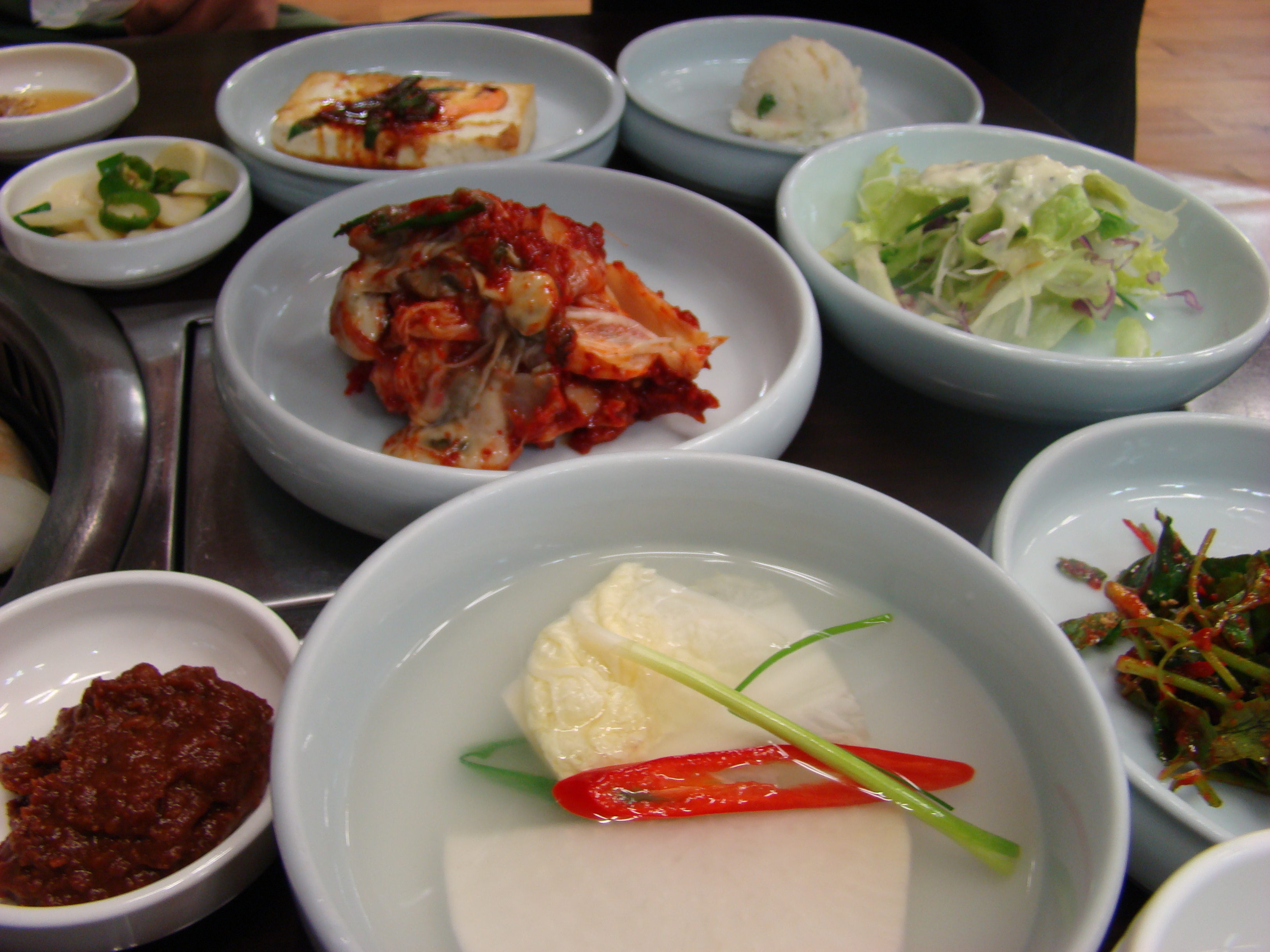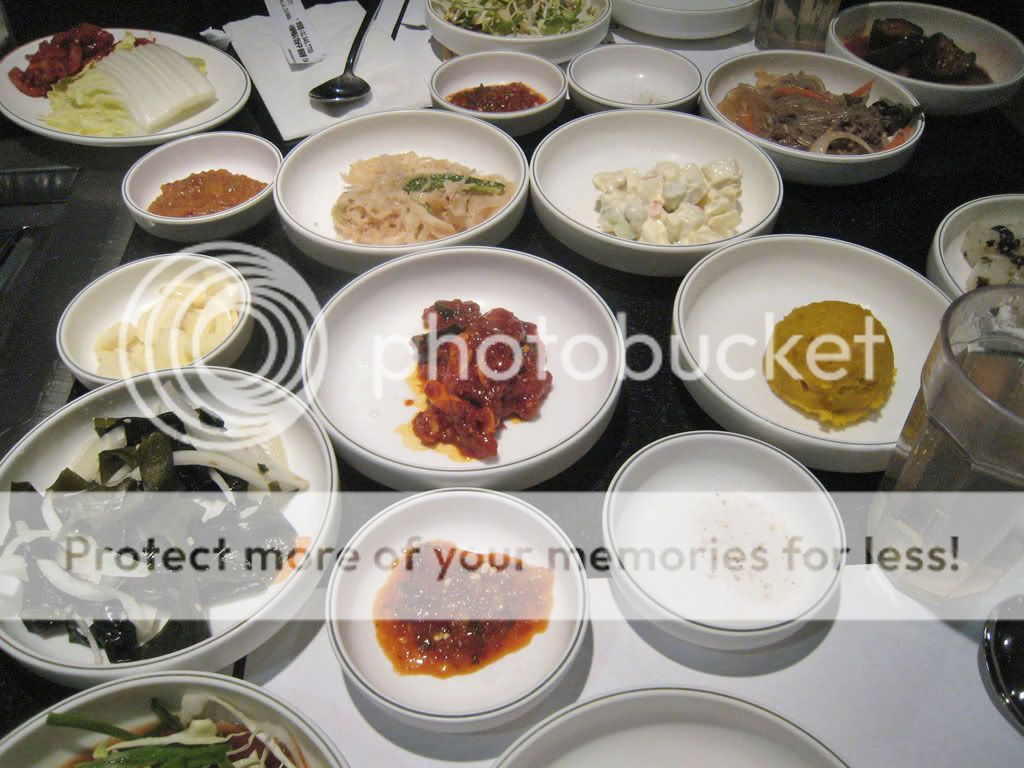Kimchi is disgusting....
Page 2 - Seeking answers? Join the AnandTech community: where nearly half-a-million members share solutions and discuss the latest tech.
You are using an out of date browser. It may not display this or other websites correctly.
You should upgrade or use an alternative browser.
You should upgrade or use an alternative browser.
Ns1
No Lifer
- Jun 17, 2001
- 55,420
- 1,600
- 126
Yes, I too can browse Wikipedia, did you see the images below that one?


When I see bowls with unappealing food in them my mind immediately goes to sushi.
banchan =/= kimchi
banchan = small appetizers/side dishes. Kimchi is often served as banchan.
Below is an excellent spread of banchan. You can see several kimchi dishes as well as several non-kimchi dishes. I srsly hate kimchi unless it's from this place.

Last edited:
SagaLore
Elite Member
- Dec 18, 2001
- 24,036
- 21
- 81
Yes, I too can browse Wikipedia, did you see the images below that one?
When I see bowls with unappealing food in them my mind immediately goes to sushi.
I am in awe of your wikipedia skills, but not sure what that has to do with what kimchi is.
And not sure what kimchi has to do with sushi.
That's like comparing pizza to chinese food. You don't really know what sushi OR kimchi is, do you? :hmm:
darkxshade
Lifer
- Mar 31, 2001
- 13,749
- 6
- 81
You should see what Asians have to say about cheese... especially the stinkier ones like blue cheese and roquefort.
I'm Asian and I love bleu cheese
Ns1
No Lifer
- Jun 17, 2001
- 55,420
- 1,600
- 126
You should see what Asians have to say about cheese... especially the stinkier ones like blue cheese and roquefort.
this.
when you REALLY think about it, cheese is so much more disgusting than kimchi.
Yes, I too can browse Wikipedia, did you see the images below that one?


When I see bowls with unappealing food in them my mind immediately goes to sushi.
Those bowls are side dishes usually consisting of potatoes, potato salad, kimchi (cabbage), kaktugi (radish), cucumbers, bean sprouts, spinach, fried eggs with seaweed, and numerous others. Don't see how it reminds you of sushi.
Lemon law
Lifer
- Nov 6, 2005
- 20,984
- 3
- 0
What was the old Alka Selser commercial, Try it you will like it-----I thought I would die. There is a lesson there, may be you will like it or maybe not, but if you don't best have a back up plan. Columbus took a chance, and look at the damn mess we are now in?
As for our OP, its clear he has too many Korean friends. Maybe you should find some low brow friends, collard greens, corn bread, black eyed peas, and fried green Tomatoes. Every one has their soul food, yum yum, snails, termites, birdnest soup, and how could I pass on Urine soaked eggs? And in all due respects, Sagalore, your picture looks more like something someone vomited back into a clean bowl even before the stomach could start digesting it.
I have a better plan, don't have any friends, and eat what you want.It works for sexual gratification too, just three nights ago, I had the best mind blowing sex I ever experienced. Never mind the fact I was alone at the time, but I know what I like.
As for our OP, its clear he has too many Korean friends. Maybe you should find some low brow friends, collard greens, corn bread, black eyed peas, and fried green Tomatoes. Every one has their soul food, yum yum, snails, termites, birdnest soup, and how could I pass on Urine soaked eggs? And in all due respects, Sagalore, your picture looks more like something someone vomited back into a clean bowl even before the stomach could start digesting it.
I have a better plan, don't have any friends, and eat what you want.It works for sexual gratification too, just three nights ago, I had the best mind blowing sex I ever experienced. Never mind the fact I was alone at the time, but I know what I like.
Last edited:
zerogear
Diamond Member
- Jun 4, 2000
- 5,611
- 9
- 81
Cheese is disgusting. How about that ?
Love kimchi, hate cheese.
QueBert
Lifer
- Jan 6, 2002
- 23,043
- 1,212
- 126
Kimchi = veggies with an assload of spices and seasoning on them. Very few people would say "oh my goooood these plain veggies are so delicious" put those same spices on a steak it would taste better than Kimchi imho. People like the spices not the actual food here.
Ns1
No Lifer
- Jun 17, 2001
- 55,420
- 1,600
- 126
Kimchi = veggies with an assload of spices and seasoning on them. Very few people would say "oh my goooood these plain veggies are so delicious" put those same spices on a steak it would taste better than Kimchi imho.
You forgot the "bury in ground and let ferment for months" part.
QueBert
Lifer
- Jan 6, 2002
- 23,043
- 1,212
- 126
You forgot the "bury in ground and let ferment for months" part.
Ummmmm, appetizing.
Lemon law
Lifer
- Nov 6, 2005
- 20,984
- 3
- 0
-----------------------------------------------------------------------------------------you know what's disgusting, OP?
YOUR FACE!
What an incredibly foolish zimfamious, as you make a common mistake in confusing our avatars with our actual identities and faces.
Think think zimfamious, our OP on this thread might taste absolutely delicious if properly boiled, broiled, or otherwise properly spiced. Maybe slowly barbequed over a charcoal fire and properly smoked might be a better option.
But every year about this time it all goes dry, for me its a tradition that 7/23 whatever should be the silly season on anand tech.
You forgot the "bury in ground and let ferment for months" part.
Bury in ground? It's not buried in the ground, it's just bottled in a jar and not fermented for months. You can eat fresh kimchi the same day it's made but it gets more flavor over time.
- Jan 2, 2006
- 10,455
- 35
- 91
I'm glad I'm Asian, raised in the US, and culinarily adventurous.
Love stinky cheeses.
Love kimchi.
Love stinky tofu.
Love eating bones/shells/cartilege/eyeballs/intestines/stomach/offal/feet/brains/ears.
Mmmmmm...
Love stinky cheeses.
Love kimchi.
Love stinky tofu.
Love eating bones/shells/cartilege/eyeballs/intestines/stomach/offal/feet/brains/ears.
Mmmmmm...
Ns1
No Lifer
- Jun 17, 2001
- 55,420
- 1,600
- 126
Bury in ground? It's not buried in the ground, it's just bottled in a jar and not fermented for months. You can eat fresh kimchi the same day it's made but it gets more flavor over time.
Yes you can eat kimchi fresh but that's historically not it's purpose.
Kimchi, which gets its name from the Chinese word ‘chimchae’ (沈菜meaning salt-pickled vegetables, is a Korean fermented vegetable, one of many in the Korean tradition of fermented food. The Chinese and Japanese have their own versions of vegetables soaked in brine, dwenjang (fermented bean paste), and kanjang (soy sauce), but there is nothing quite like Korean kimchi.
Between the end of October and the middle of November each year, most Korean households take part in an annual event known as ‘kimjang’. During this period, they prepare their stores of kimchi to get them through the 3 or 4 cold months of winter. A long time ago, before Koreans had develeped methods such as vinyl greenhouses of counteracting the severe winter weather, kimjang was the only means of ensuring a ready supply of vegetables through the winter.
I hate ripping wiki but...
Traditionally, the greatest varieties of kimchi were available during the winter. In preparation for the long winter months, many types of kimjang kimchi (hangul: 김장 김치were prepared in early winter and stored in the ground in large kimchi pots. Today, modern kimchi refrigerators offering precise temperature controls are used to store kimjang kimchi. November and December are traditionally when people begin to make kimchi; women often gather together in each others' homes to help with winter kimchi preparations. "Baechu kimchi" is made with salted baechu filled with thin strips of radish, parsley, pine nuts, pears, chestnuts, shredded red pepper, manna lichen (석이버섯
, garlic, and ginger.
...
The shortages have come at the onset of gimjang season, when families lovingly hand-prepare the kimchi they will consume during the winter and spring. Many prefer kimchi that has fermented for months or even years in earthenware pots.
The kimchi joint I go to serves several types of kimchi that have been fermenting for differing lengths of time.
Yes you can eat kimchi fresh but that's historically not it's purpose.
I hate ripping wiki but...
...
The kimchi joint I go to serves several types of kimchi that have been fermenting for differing lengths of time.
That was a long time ago before refrigeration. Ever since 25+ years ago, it's been done bottling in jars and put in refrigerators. No one makes kimchi like that anymore, all the ones you buy in the asian stores are made like that.
Ns1
No Lifer
- Jun 17, 2001
- 55,420
- 1,600
- 126
That was a long time ago before refrigeration. Ever since 25+ years ago, it's been done bottling in jars and put in refrigerators. No one makes kimchi like that anymore, all the ones you buy in the asian stores are made like that.
no arguments here, but they're still usually fermented for various lengths of time.
Last edited:
IAteYourMother
Lifer
- Nov 3, 2004
- 10,491
- 22
- 81
That was a long time ago before refrigeration. Ever since 25+ years ago, it's been done bottling in jars and put in refrigerators. No one makes kimchi like that anymore, all the ones you buy in the asian stores are made like that.
eh, my grandma makes it that way, it's perfectly reasonable to casually suggest that you make kimchi by burying it and fermenting. But I guess you seem to take your modern kimchi production very seriously...
zinfamous
No Lifer
- Jul 12, 2006
- 111,905
- 31,435
- 146
guys, there's nothing unusual, nor uniquely Korean about how kimchi is prepared. Almost all cultures have their "fermented/pickled" staple food that has existed on this planet longer than has monotheism.
One of the central reasons that humans are so awesome is that we figured out how to make things like bread, beer, saurkraut/kimchi. We exploited little itty bitty microorganisms to do our bidding--long before we knew how they worked, or that they even existed--kimichi is just an eastern version of saurkraut, and vice versa, and not terribly different from miso, and the various central american cabbage dishes.
oh, and also: beer.
One of the central reasons that humans are so awesome is that we figured out how to make things like bread, beer, saurkraut/kimchi. We exploited little itty bitty microorganisms to do our bidding--long before we knew how they worked, or that they even existed--kimichi is just an eastern version of saurkraut, and vice versa, and not terribly different from miso, and the various central american cabbage dishes.
oh, and also: beer.
Cerb
Elite Member
- Aug 26, 2000
- 17,484
- 33
- 86
Kimchi is a gift from the gods. Whenever I have some, I'll occasionally open the jar just to smell it.I have no clue why people like this.....
Every time my friends make it they insist I try it. I gag and almost hurl.
http://en.wikipedia.org/wiki/Kimchi
BLEH.
Speaking of which, I have an attempt at cucumber kimchi I need to check on...
It's bland. If you go to any area with Korean grocers, go buy some that they make. It will all be darker, redder, and more pungent.King brand spicy got me to post the thread above. I don't know how it compares to anything else, but I thought it was delicious.
It's the extra spices that make kimchi special. It's like Tex-mex, in that kicks it up a few notches.guys, there's nothing unusual, nor uniquely Korean about how kimchi is prepared. Almost all cultures have their "fermented/pickled" staple food that has existed on this planet longer than has monotheism.
Miso is quite different. It uses beans and grains, and starts off with controlled use of spores. Similar end result in terms of fermentation, but not at all like kraut or kimchi, which are basically throwing vegetables (maybe some meat), herbs, and and salt into a jar and then just making sure it never gets too hot.and not terribly different from miso
OP are your friends Korean as in 1st generation families just moved here or are they basically Americans with Korean heritage? Kimchi done right is amazing.
Best kimchi I ever had was a small family restaurant somewhere in like bongilchon. We had to bring a katusa cause no one who worked or ate at the place spoke english, they usually didn't see Americans. But holy shit was that kimchi fucking good. Just fucking perfect.
Worst kimchi I ever had.. yall think the canned stuff is gross? Try chow-hall kimchi.... its canned shit that gets shoved back in the fridge every night and reused for weeks on end cause no one eats it cause its fucking death incarnate.
Best kimchi I ever had was a small family restaurant somewhere in like bongilchon. We had to bring a katusa cause no one who worked or ate at the place spoke english, they usually didn't see Americans. But holy shit was that kimchi fucking good. Just fucking perfect.
Worst kimchi I ever had.. yall think the canned stuff is gross? Try chow-hall kimchi.... its canned shit that gets shoved back in the fridge every night and reused for weeks on end cause no one eats it cause its fucking death incarnate.
T_Yamamoto
Lifer
- Jul 6, 2011
- 15,007
- 795
- 126
Kimchi is amazing if the family can make it right.
Its a traditions and a cultural food. Sorta like america and grilled cheese sandwiches?
Its a traditions and a cultural food. Sorta like america and grilled cheese sandwiches?
TRENDING THREADS
-
Discussion Zen 5 Speculation (EPYC Turin and Strix Point/Granite Ridge - Ryzen 9000)
- Started by DisEnchantment
- Replies: 25K
-
Discussion Intel Meteor, Arrow, Lunar & Panther Lakes + WCL Discussion Threads
- Started by Tigerick
- Replies: 23K
-
Discussion Intel current and future Lakes & Rapids thread
- Started by TheF34RChannel
- Replies: 23K
-
-

AnandTech is part of Future plc, an international media group and leading digital publisher. Visit our corporate site.
© Future Publishing Limited Quay House, The Ambury, Bath BA1 1UA. All rights reserved. England and Wales company registration number 2008885.

